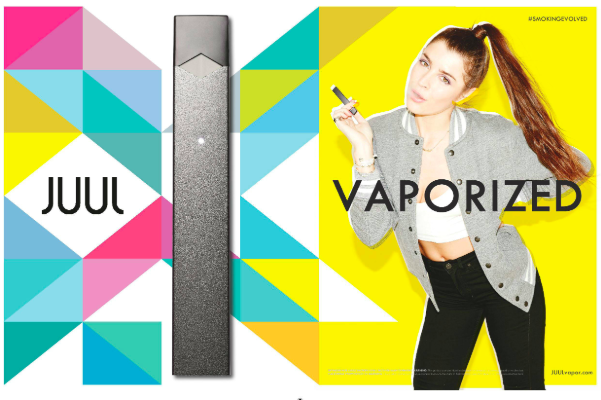
Exposure to e-cigarette advertisements has been shown to significantly increase susceptibility to vaping amongst adolescents [1]. A recent study published in Tobacco Induced Diseases found that advertising on social media and around vape retailers are significant areas of exposure to vaping in young people [2]. Some evidence has shown that the more types of media that advertise vaping to young people, the lower their harm perception is of the practice [3]. Along with decreasing risk perceptions, e-cigarette advertisements may also generate curiosity and increase the risk of use amongst young people [3].

An example of an advertisement from JUUL’s youth-oriented ‘Vaporized’ campaign in the US.
Social media has become a powerful marketing and advertising tool for the vaping industry. Vape companies utilise social media platforms to promote their products, reach a wider audience, and create brand awareness. Apart from advertising, footage of vaping is also shared via popular young influencers and user-generated content, with a recent investigation conducted by Quit and VicHealth finding there were more than 18 billion posts with vaping-related hashtags across Instagram and TikTok [4]. The study also found that many vape retailers pose as personal accounts on social media and falsely appear to be non-promotional [4]. Exposure to these images and videos can normalise and glamorise vaping, especially amongst younger audiences who are more susceptible to peer influence. This exposure may encourage young people to pursue vaping by portraying it as cool, enticing, and normal [4]. Alarmingly, content shared by vape retailers has also targeted young people by offering tips on how to hide vapes at school and at home [4].

Image from Quit and VicHealth
Due to the detrimental effects of vaping and vape advertising, the World Health Organisation has suggested a ban on e-cigarette marketing and sponsorship [2]. With young people so active on social media, it is essential that their exposure to vaping-related content is reduced and unethical marketing tactics are abolished.
What can be done to help manage this content on social media?
While we can’t fully escape unwanted content and advertising, there are measures that can be put in place to limit exposure. For example, it is possible to hide suggested posts on an Instagram feed, or stop seeing suggested posts with certain words, which will also extend to hashtags (for example #vape). You can read more about parental Supervision on Instagram here, and read about content controls on TikTok here. TikTok’s Family Pairing feature also allows parents to set content controls for their teens, including being able to turn on Restricted Mode, and filter out certain keywords or hashtags.
While advertising bans and increased regulations around e-cigarettes are important, it’s also crucial to educate young people to make informed decisions and equip them with the skills to say no to vapes. OurFutures delivers evidence-based prevention education utilising a comprehensive social influence and harm minimisation approach. Our vaping prevention program has been co-designed with young people, teachers, and education experts and we’re now evaluating it in a large randomised controlled trial across NSW, QLD, and WA.
To learn more about the OurFutures Vaping Trial, head here.
To read more about vaping, the risks involved and what can be done to tackle the issue, read our article here.
Prevention is key.

References:
- H. Dai and J. Hao, “Exposure to Advertisements and Susceptibility to Electronic Cigarette Use Among Youth,” Journal of Adolescent Health, vol. 59, no. 6, pp. 620–626, Dec. 2016, doi: https://doi.org/10.1016/j.jadohealth.2016.06.013.
- Pettigrew, Simone et al. “Exposure to e-cigarette advertising and young people’s use of e-cigarettes: A four-country study.” Tobacco Induced Diseases, vol. 21, no. October, 2023, 141. doi:10.18332/tid/172414.
- L. Wang, J. Chen, S. Y. Ho, L. T. Leung, M. P. Wang, and T. H. Lam, “Exposure to e-cigarette advertising, attitudes, and use susceptibility in adolescents who had never used e-cigarettes or cigarettes,” BMC Public Health, vol. 20, no. 1, Sep. 2020, doi: https://doi.org/10.1186/s12889-020-09422-w.
- VicHealth, “How vaping advertisers target young people,” www.vichealth.vic.gov.au, Sep. 15, 2023. https://www.vichealth.vic.gov.au/news-publications/research-publications/how-vaping-advertisers-target-young-people#:~:text=VicHealth%2C in partnership with Quit
- “Advertising nicotine vaping products to the Australian public,” Therapeutic Goods Administration (TGA), Jun. 21, 2022. https://www.tga.gov.au/resources/resource/guidance/advertising-nicotine-vaping-products-australian-public







